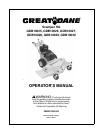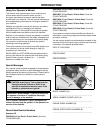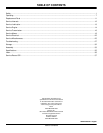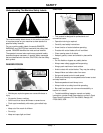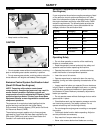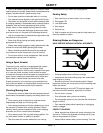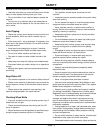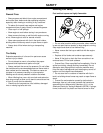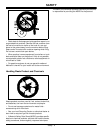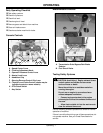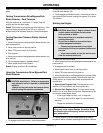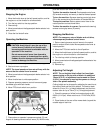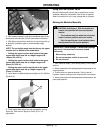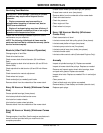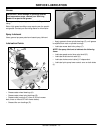
Safety - 5
SAFETY
as needed.
Prevent Fires
• Remove grass and debris from engine compartment
and muffler area, before and after operating machine,
especially after mowing or mulching in dry conditions.
• To reduce fire hazard, keep engine and engine
compartment free of grass, leaves, or excessive grease.
• Clean up oil or fuel spillage.
• Allow engine to cool before storing in any enclosure.
• Never remove fuel cap, or add fuel with engine running
or hot. Allow engine to cool for several minutes.
• Never store equipment with fuel in the tank inside a
building where fumes may reach an open flame or spark.
• Always shut off fuel when storing or transporting
machine.
Tire Safety
Explosive separation of a tire and rim parts can cause
serious injury or death:
• Do not attempt to mount a tire without the proper
equipment and experience to perform the job.
• Always maintain the correct tire pressure. Do not inflate
the tires above the recommended pressure. Never weld or
heat a wheel and tire assembly. The heat can cause an
increase in air pressure resulting in a tire explosion.
Welding can structurally weaken or deform the wheel.
• When inflating tires, use a clip-on chuck and extension
hose long enough to allow you to stand to one side and not
in front of or over the tire assembly.
• Check tires for low pressure, cuts, bubbles, damaged
rims or missing lug bolts and nuts.
Handling Fuel Safely
Fuel and fuel vapors are highly flammable:
• Do not refuel machine while you smoke, when machine
is near an open flame or sparks, or when engine is running.
Stop engine and allow to cool before filling.
• Never remove the fuel cap or add fuel with the engine
running.
• Replace all fuel tanks and container caps securely.
• Never fill fuel tank or drain fuel from a machine in an
enclosed area. Fill fuel tank outdoors.
• Prevent fires. Clean up spilled fuel immediately. If fuel is
spilled on clothing, change clothing immediately. Do not
attempt to start the engine but move the machine away
from the area of spillage and avoid creating any source of
ignition until fuel vapors have dissipated.
• Do not store fuel in container or machine with fuel in
tank in a building where fumes may reach an open flame or
spark.
• Prevent fire and explosion caused by static electric
discharge. Use only non-metal, portable fuel containers
approved by the Underwriter’s Laboratory (U.L.) or the
American Society for Testing & Materials (ASTM). If using a
funnel, make sure it is plastic and has no screen or filter.



